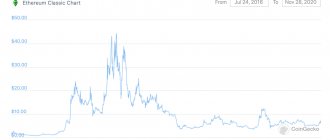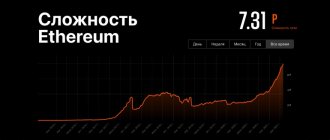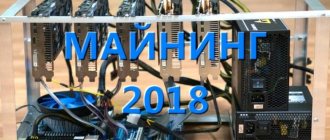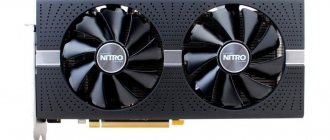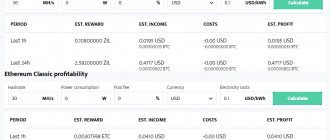AMD VII profitability
The current market price and mining profitability of the AMD VII graphics card fluctuates depending on the value of the cryptocurrency. The information in the plate is updated once a day.
View the full graphics card profitability table with the ability to sort by price, revenue, and ROI.
| Price | ETH | ETC | EXP | UBQ | RVN | BEAM | Profit | Payback |
| 216543.63 ₽ | 95.0 Mh/s | 95.0 Mh/s | 95.0 Mh/s | 95.0 Mh/s | 30.0 Mh/s | 33.2 H/s | 342.12 ₽ 10605.72 ₽ | 632 days |
Radeon VII turned out to be the fastest video card for Ethereum mining
AMD's video card has once again become the leader in the mining of the Ethereum cryptocurrency. The flagship graphics accelerator Radeon VII was able to outperform previous video cards based on Vega, and Radeon Pro Duo based on two Fiji GPUs, and even the previous leader - NVIDIA Titan V based on Volta.
The Radeon VII video card out of the box, that is, without any modifications or changes, is capable of providing a mining speed of 90 Mhash/s. That's almost triple the performance of the Radeon RX Vega 64 out of the box, and 29% more than the Radeon Pro Duo. The difference with the Titan V is also significant - the NVIDIA video card is capable of providing a hashrate of 69 Mhash/s in the standard configuration.
Using various manipulations with parameters, you can increase the hashrate of the Radeon VII video card up to 100 Mhash/s. However, it would be more optimal to reduce power consumption from 319 to 251 W, while overclocking the memory from 1000 to 1100 MHz, and forcing the GPU to operate at a voltage of 950 mV at a frequency of 1750 MHz. Under such conditions, the production rate will be 91 Mkhesh/s, and efficiency will increase by 21%.
Of course, for other video cards, using optimizations you can also achieve an increase in hashrate. For example, for Titan V, optimizations allow us to reach 82 Mhash/s. In turn, Radeon RX Vega 64 is capable of “mining ether” at a speed of 44 Mhash/s. It is also worth noting that for NVIDIA GeForce GTX 1080 and GTX 1080 Ti video cards there are special software patches that provide a significant increase in hashrate to 40 and 50 Mhash, respectively, or even higher. This also reduces energy consumption.
Compared to the Titan V, the new Radeon VII not only has higher performance, but also a much more attractive price - video cards cost $3,000 and $700, respectively. Compared to other graphics accelerators, Radeon VII outperforms in terms of performance and energy consumption. For example, three Radeon RX 570 or RX 580 with a hashrate comparable to one Radeon VII will consume more power. In the case of the GeForce GTX 1080 and GTX 1080 Ti, the situation is similar: comparable performance is provided with higher power consumption.
I would also like to separately dwell on where such a big difference between the Radeon RX Vega 64 and Radeon VII came from. It's all about memory and its bandwidth. While the Radeon RX Vega 64 had 8 GB HBM2 with 484 GB/s bandwidth, the newer Radeon VII has 16 GB HBM2 with 1 TB/s bandwidth. At the same time, the power consumption of video cards is approximately at the same level, which makes Radeon VII a much more interesting solution for mining.
However, there is an obvious disadvantage here: mining profitability is currently not at the highest level, and even with such a high hashrate, it is unlikely that it will be possible to make a big profit using Radeon VII. If only this video card had existed a year and a half ago...
AMD VII hashrate
We have compiled a table of AMD VII hashrates for popular algorithms. If you are just choosing a video card for mining, and already know what coin you will mine, then you can estimate the approximate performance from the table. We also have an article about what hashrate is.
| Coin | Algorithm | Hashrate |
| Ethereum (ETH) | DaggerHashimoto ETH | 95.0MH/S |
| Ethereum Classic (ETC) | Etchash | 95.0MH/S |
| Expanse (EXP) | DaggerHashimoto EXP | 95.0MH/S |
| Ubiq (UBQ) | Ubqhash | 95.0MH/S |
| Monero (XMR) | RandomX | 1400.0 H/S |
| Ravencoin (RVN) | KawPow | 30.0 MH/S |
| Beam (BEAM) | BeamHashIII | 33.2 H/S |
Which video cards for mining to buy from AMD in 2022
In principle, you can start mining cryptocurrency on any GPU, even an RX 550, however, whether it will be profitable is another question. In this review, we want to give our recommendations on which video cards for mining you can buy now, and which ones you should avoid. We will only touch on representatives of the “red” ones, and we will talk about the “blue” ones, that is, Nvidia, in the next article.
We consider profitability using the example of the Nicehash pool at an electricity cost of 5.92 rubles.
RX 470/480/570/580
Until today, representatives of the RX 4** and 5** model range are the best in the field of cryptocurrency mining. The excellent combination of hashrate and energy consumption allows them to generate significant income.
Surprisingly, these are the only adapters that can pay for themselves in less than 1 year. But you will have to look for them only on the secondary market, and not every seller will agree to give at least some kind of guarantee. The only thing that needs to be taken into account is that the profit in the future will not be very high.
RX 5700XT
The second representatives of the AMD line bring more income, although they are more expensive.
They are practically not sold in stores, and on the secondary market they ask for a fairly high price. As a result, the payback is from 385.
Vega 64
A very old adapter from AMD, which is now impossible to find in stores, and even if available, it is far from a fact that this is a new device.
It is almost impossible to assemble a mining rig on video cards like Vega 64 in 2021, but if you try, you can find copies for 80. As a result, this will allow you to make a net profit after 413 days.
RX 6600XT
New models, which, of course, come in new versions with a guarantee, although the price is far from reality. The profitability of the video card in mining is decent, so it can be recommended for purchase.
It fully pays for itself in a relatively short period of 413-427 days.
RX 5600XT
With it you can earn 163.2 rubles/day.
At the same time, after 441 you will receive a net profit.
RX 6700XT
Although it is called a budget model in the line, but with the current rush for the best video cards for mining, its price is greatly inflated. It is interesting that 6*** appeared later than 5***, but at the same time they perform somewhat worse in cryptocurrency mining.
Such an acquisition will pay for itself only after 442 days.
Vega 56
For a long time, this family was the leader in crypto mining on ETHash Cryptonight, but in 2022 the situation changed, and now the 56th is almost at the bottom of the list in terms of profitability.
The used market also played a cruel joke, where it is presented at a very high price of 70,000 rubles. It will only take 449 days to break even with Vega 56.
Radeon VII
It seems to be an excellent video card with a super profitability of 408.3 rubles, which is the maximum among all the models presented here.
But such a video card for mining will pay for itself only after 471 days, since its price on the secondary market is 190,000. We did not put it in 1st place only because it is very difficult to find a complete Radeon VII for sale, and everything that is presented on the market - used products. No one will give a guarantee on them, so you need to be prepared for possible problems.
RX 6900 XT and 6800 XT
The mining calculator for video cards shows that these 2 “sisters” will bring 281.8 and 276.1 r/day, respectively, so we combined them into one rating point.
You can easily find new ones in the store, but be prepared to pay from 133,000 rubles for such a purchase. To start earning money you will have to spend 452 and 518 days, since that is how long it takes to pay back.
AMD VII driver
When installing AMD VII drivers, it is always recommended to uninstall the current drivers first. This way you can be sure that DCH drivers will not be installed by Windows 10.
For older AMD video cards (for example, AMD R9 290 or AMD HD 7870), Catalyst (Crimson) 15.12
can show the best performance and compatibility.
For other video cards, the latest driver version from the official website of the AMD manufacturer is best suited.
Review of AMD Radeon VII 16 GB video card
- Memory – 16 GB HBM2 (Micron);
- Core frequency – 1400 MHz (boost – 1800 MHz);
- Memory frequency – 1600 MHz;
- Energy consumption – from 180 to 310 W;
- Interface - PCI Express 3.0 16x;
- Length - 27 cm;
- Weight - 1.85 kg;
- Noise level - 52 dB;
Perhaps the most important thing about Radeon VII is that the graphics chip is manufactured using the latest 7-nanometer process technology by the Taiwanese company Taiwan Semiconductor Manufacturing Company (TSMC). The use of such a chip helped AMD increase the performance and improve the energy efficiency of the video card. In this regard, AMD decided to set the same price for the Radeon VII as its main competitor - the GeForce RTX 2080 for $925.
Radeon VII packaging and features
The video card comes in a huge box. There is nothing superfluous in it: a manual, several branded books with a brief description and one sticker.
The Radeon VII itself looks very solid thanks to the silver casing and three large FirstD fans with a diameter of 75mm.
By the way, about the fans. In idle mode they operate at a speed of 800 rpm, and in mining 3000 rpm or more. In principle, the fans are the same as in the SAPPHIRE series, and this is very good, since they are the reference ones in the video card market.
However, the length of the video card is almost standard (27 cm), and the thickness is the size of two PCI slots.
The back side of the Radeon VII is covered with a perforated metal plate. On the side there are two 8-pin connectors, which are already familiar to many gamers and miners.
An interesting thing is that the Radeon branding and the end cube in the “R” corner are illuminated with bright red LEDs.
The interface panel contains the usual three DisplayPorts and one HDMI.
If you disassemble the Radeon VII, you will notice that AMD used a special thermal sticker instead of thermal paste, which has thermal conductivity (30-40 W/mK). And this figure is many times higher than that of top thermal pastes (13 W/mK).
Radeon VII Memory and Power Consumption
As we already wrote at the beginning of the review, the video card is equipped with 16 GB HBM2 memory from the American corporation Micron. As for power consumption, the Radeon VII consumes from 180 W to 300 W depending on the load (note, both in games and in cryptocurrency mining), where 75 W goes through the riser, and the remaining 100-200 W through the eight-pin connectors on the power supply.
For a mining farm consisting of two video cards and all other hardware (GPU, HDD, DDR4), you will need one 1000 W power supply. Accordingly, if there are four video cards, then two 1000 W power supplies are needed.
Best graphics card for mining: Key characteristics when choosing a GPU
GPUs for assembling mining farms are selected based on hashrate. This is the speed at which the card can solve mathematical equations. What affects hashrate:
- VRAM (video memory) volume. Calculations require space to store variables and equations, so memory size affects the rate at which the graphics card makes money. The optimal size in 2022 is considered to be 6 gigabytes or more, but there are also mining methods on cards with 4 GB of memory.
- Memory bus width. What connects the video card processor and its memory. The bus has a “width”—the length of the bits it can transmit in one clock cycle. For example, a card with a 256-bit bus will perform better than a 128-bit one. It's hard to make a mistake - the more, the better. 512 and 1028 bits will work much faster if the miner client is optimized for them, but the cost of such cards is higher. The people's choice for 2021 is the 256-bit memory bus.
- Cooling system. Copper tubes or aluminum radiators. Ideally, copper radiators, but this will require modification of the card with a file from familiar radio technicians. The number of fans is not critical. Two will do, three is generally good, but having them won’t make much difference if the card is properly downvolted. A GPU with a turbine - one powerful fan in the case - makes noise like a Hayabusa crankshaft, take this into account when assembling.
- Energy consumption. A great reference for this point is the technological process used to create the transistors for the chip. For example, a card with a 14 nm process technology will be cooler than a card with a 22 nm chip, all other inputs being equal. In mining, it is customary to use what is available, so the decisive factor will not be the technical process, but the availability of hardware.
- Video chip frequency. A strictly conditional measure. By 2022, there will be no cards with a processor frequency below 1 GHz in mining. The higher the frequency, the higher the temperature, so when you buy a card with a high frequency, it can be artificially lowered.
- Memory chips . Triple mantra: Hynx, Samsung, Micron. If you have a memory chip from one of these manufacturers, you can adjust the memory frequency. You can find out the manufacturer using the GPU-z program (the manufacturer is indicated in the Memory Type field).
- Do not take PRO, VEGA or Titan. They cost like BMWs, but they dig unsatisfactorily and eat a lot. Old models of these lines at a low price can serve as a heater in winter, but I still don’t recommend them.
Radeon VII hashrate using various algorithms
When mining cryptocurrencies that use algorithms that require high-performance video memory systems, the Radeon VII video card shows results that are not comparable to other models of the same class.
It should be borne in mind that the potential of this card has not yet been fully revealed to miners due to the fact that AMD is always late in releasing the most powerful drivers. Even in driver version 19.3.1, according to official information, the settings of Radeon WattMan, AMD’s own utility, which is included in the driver package, do not work stably.
Radeon VII in cryptocurrency mining
As of October 2022, Radeon VII is the best mining cryptocurrency based on the Ethash algorithm. Let's finally take a look at the performance of the video card on different mining algorithms, as well as power consumption.
- Ethash (Ethereum, Metaverse, Ethereum Classic, Ubiq, Pirl, Musicoin) – 78 MH/s – 230 W;
- Lyra2REv2 (Hanacoin, Vertcoin) – 90 MH/s – 240 W;
- BCD (Bitcoin Diamond) – 23 MH/s – 240 W;
- Aion (Aion) – 160 h/s – 160 W;
- CryptoNightHeavy (Loki) – 630 h/s;
- Hex (XDNA) – 78 MH/s – 230 W;
- NeoScrypt (Inova, Traid, Feathercoin, Gobyte) – 2150 kh/s – 250 W;
- TimeTravel10 (Bitcore) – 30 MH/s – 240 W;
- CryptoNightR (Monero, Graft) – 2800 h/s – 240 W;
- Cuckatoo31 (GRIN) – 0.95 h/s – 200 W;
- X16Rv2 (Ravencoin) – 23 MH/s – 240 W;
- ProgPow (Bitcoin Interest) – 24 MH/s – 270 W;
- CuckooCycle (Aeternity) – 5 h/s – 190 W;
- Zhash (Bitcoin Gold, BitcoinZ) – 49 h/s – 180 W;
Radeon VII hardware and its capabilities
The Radeon VII video card has the following technical characteristics (for a more clear comparison, we post information about the RTX 2080Ti, 2080, 2070, GTX1660Ti video cards and the younger brother from AMD - RX590).
Table of characteristics of the Radeon VII video card in comparison with new products from Nvidia:
| Parameter | Video card model | |||||
| AMD Radeon VII | RTX 2080Ti | RTX 2080 | RTX 2070 | GTX1660Ti | AMD RX590 | |
| Start of production | February 2019 | September 2018 | September 2018 | October 2018 | February 2019 | November 2018 |
| Price, dollars USA | 850 | 1190 | 810 | 570 | 340 | 320 |
| Technical process, nm | 7 | 12 | 12 | 12 | 12 | 12 |
| GPU | Vega 20XT | TU102 | TU104 | TU106 | TU116 | Polaris 30 |
| Crystal area, sq. mm | 331 | 754 | 545 | 445 | 284 | 232 |
| Number of transactors, billion. | 13,23 | 18,6 | 13,6 | 10,8 | 6,6 | 5,7 |
| Number of cores multipot. Comput. | 3840 | 4352 | 2944 | 2304 | 1536 | 2304 |
| Number of computer blocks Computing (CU/Rop) | 60 | 88 | 88 | 64 | 48 | 36 |
| Memory capacity, GB | 16 | 11 | 8 | 8 | 6 | 8 |
| Memory type | HBM2 | GDDR6 | GDDR6 | GDDR6 | GDDR6 | GDDR5 |
| GPU core frequency, MHz | 1750 | 1545 | 1545 | 1620 | 1770 | 1560 |
| Comput. power, GFLOPS | 13,44 | 14,2 | 10,5 | 7,,8 | 5,437 | 7,1 |
| Effective memory frequency, Mbps | 2000 | 14000 | 14000 | 14000 | 12000 | 8000 |
| Memory bus width | 4096 | 352 | 256 | 256 | 192 | 256 |
| Pass. memory capacity, GB/sec | 1024 | 616 | 448 | 448 | 288 | 256 |
| Consumption power, watt | 295 | 260 | 225 | 185 | 120 | 225 |
Which cards are best for mining?
Which manufacturers of video cards for mining deserve attention? After testing GPUs from the flagships on the market Nvidia and AMD, Nvidia video cards showed the best capabilities. However, given the fact that Ether mining has received a new life, AMD cards should not be written off as the company's Vega and RX generations are still very suitable for Ethash algorithms. Regardless of the manufacturer, the most important factor is the return on investment, as any miner must first invest a decent amount of money before making any profit.
What is the difference between the Radeon 7 and the RTX2080Ti for better and worse?
When comparing the flagship from AMD and its direct competitor from Nvidia - the top-end video card RTX 2080Ti, we can note the following positive qualities of the Radeon VII, which have a positive effect on mining:
- Radeon VII was released using a more advanced 7 nm process technology compared to Nvidia's 12 nm;
- The memory capacity of the seventh Radeon is larger than that of the RTX2080Ti by as much as 5 gigabytes of productive memory, which provides a solid foundation for the future;
- the price of Radeon VII is 40% lower than the cost of the RTX 2080Ti and comparable to the price of the RTX 2080;
- although the effective frequency of the HBM2 memory used in the Radeon VII is 7 times lower compared to GDDR6 in the RTX1080Ti, its bandwidth is 66% higher due to the 11.6 times larger memory bus width;
- Based on the experimental results, the smaller the size of the crystals used, the lower the possible downvoltage, so it is quite possible to reduce the consumption of the seventh generation Radeon by reducing the core voltage to values of the order of 800 mV.
The possibility of downvolting up to 712 mV at a core frequency of 808 MHz is confirmed by a graph of the core frequency versus voltage from the Global Wattman program:
In practice, you can change the core voltage from 808 to 1218 mV.
Radeon VII is worse than RTX2080Ti in the following characteristics:
- Due to the 13% smaller number of cores for multi-threaded computing, the theoretical performance of multi-threaded computing in the Radeon VII is 5.6% lower than that of the RTX2080Ti, which should affect the mining of cryptocurrencies that require core frequency. RTX's lead here is not so great due to the higher clock speed of the Vega 20 XT GPU, which is possible thanks to the 7 nm process technology;
- The Radeon 7 has 60 Compute Units, while the 2080ti has 88 Rop (64 Units for the Radeon Vega64 and 36 Units for the RX590). Probably due to imperfect technical progress, 4 CU units of the seventh Radeon are disabled;
- The power consumption of the Radeon VII is 15% more than that of the RTX2080Ti, which is quite significant given the current profitability in the cryptocurrency mining market.
